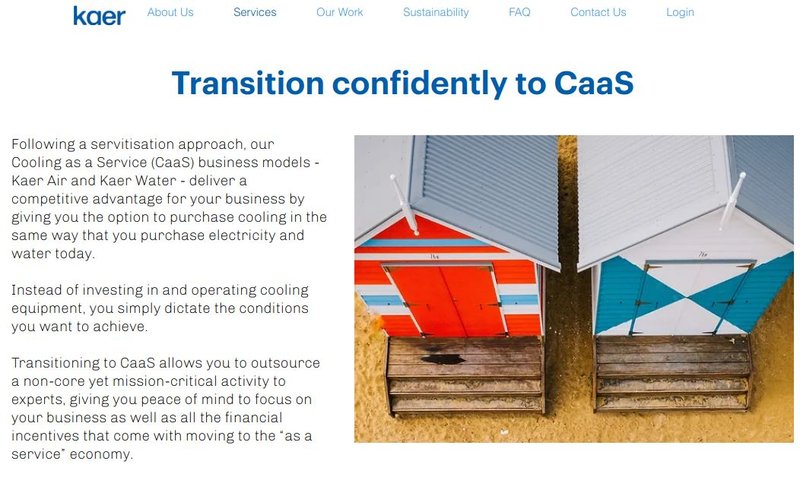Product-As-A-Service Business Model: Everything You Need To Know
Do you sell physical equipment but feel exhausted from chasing sales every month? Consider pivoting to product-as-a-service business model.
The subscription business model has many benefits, including recurring payments that help you maintain healthy cashflow, more predictable revenue, and stronger customer relationships.
It’s no surprise, therefore, that most software companies and those that sell digital and virtual products follow a recurring revenue model.
But what if you sell expensive physical equipment? Think of industrial boilers, HVAC systems, or earthmoving equipment. Does that mean you can’t be a part of the circular economy?
You absolutely can by transitioning your business to a product-as-a-service business model. This article will teach you what the business model is all about.
Let’s dive right in.
What is product as a service (PaaS)?
Product-as-a-service (PaaS) is a service-centric business model that bundles physical products and service contracts into subscription or pay-per-use offerings. The business model focuses on outcomes over products to fulfil customer needs better.

From the consumer’s perspective, instead of buying and owning a piece of equipment, one pays for the benefit or desired result that the equipment delivers. For example, when a customer buys an AC unit, they want the cool, dehumidified air it produces, not the AC unit itself.
Under the PaaS business model, the customer pays for using the physical equipment while the manufacturer retains ownership of the product and is responsible for repairing and replacing it.
The PaaS model (not to be confused with platform-as-a-service) allows sellers of physical products to expand their revenue sources by selling to customers who would not otherwise afford their products.
Customers benefit from a flexible billing system and financial freedom from not having to splurge large amounts on expensive equipment.
How does the product-as-a-service business model work?
The PaaS model, also known as the product-service-system, reconfigures the consumer’s mindset from ownership to benefit.
The business model reinforces the maxim that a product’s value lies not in its physical form but in its function - what you can do and achieve with it. In the case of an AC unit, what you achieve with it is cool, clean indoor air.
So, the product-service-system takes a piece of equipment and reimagines the benefit it delivers to customers. You then reduce that benefit into saleable units for which you will determine a price.
With the unit price determined, you combine the charge for the total units a customer needs for a specific billing period with add-ons like insurance, maintenance, and repair to get your subscription fee. If you prefer the more straightforward pay-per-use model, customers will pay for actual usage.
If the product has complex functions that can’t be reduced to one overall benefit with a precise unit of measurement, you can use the rental billing model. But even then, you must decide what rental fee will be profitable for you and fair to the customer.
Whichever way you charge customers, you will need automatic billing software to streamline billing and collect customer payments efficiently.
To accurately and efficiently track product usage, you may also have to fit sensors on your products and connect them to remote monitoring devices.
When customers no longer need your product or decide to go with another provider, they cancel their subscription. You will then collect the product to start a new subscription with another customer.
Product-as-a-service example
We will use our example of an AC unit. You may charge a customer for the delivered volume of conditioned air (airflow), with extra charges for maintenance, insurance, depreciation, and other applicable costs. With that, you will have the basis for charging the customer on a pay-per-use contract.
If you prefer a subscription model, you will have to estimate how much conditioned air a facility requires per billing period and then add other costs that may apply to get their subscription fee.
Since temperatures change with seasons, a pay-per-use billing model that allows customers to only pay for actual usage may produce a more compelling value proposition.
It will be easier to convert prospects if your billing model does not force them to pay even when the weather is more temperate and the AC unit is not working as much.

Kaer is an example of a product-as-a-service company selling cooling instead of air conditioning equipment. A pioneer of the CaaS (cooling-as-a-service) model, the company provides cooling to commercial and industrial buildings throughout Asia.
There are many other product-as-a-service examples. One is Cool Blue, a company that leases washing machines. Cool Blue sells washing machine subscriptions where it supplies the machine that it will repair or replace if needed. In return, the customer pays a monthly recurring fee.
What are the advantages of a product-as-a-service business model?
The PaaS model is a component of the circular economy, an economic system that promotes reuse and regeneration to minimise waste and protect the environment.
The product-service-system flips the traditional linear economy concept on its head. In the linear economy, the manufacturer hands ownership and all responsibility for a product to the customer. The customer assumes ownership of the product, repairs and maintains the product, and disposes it at the end of its lifecycle.
Here are some of the benefits and attractions of the product-as-a-service model to businesses and their customers:
Allows businesses to build a continuous revenue stream
Encourages manufacturers to produce higher quality products.
Refocuses manufacturers on delivering value to customers.
Promotes sustainability.
Fosters a closer relationship with customers.
Want to turn a product into a service? What you need to know.
Almost all physical products that can be rented fit the product-as-a-service business model. This includes all mechanical equipment.
However, to establish a more prosperous and sustainable business, it is essential that you clearly understand your customers’ needs and services. If you don’t, you may waste time and money selling them something they don’t need.
You must nail your value proposition and then deliver on the benefits you are promising. That means single-mindedly focusing on providing value to customers because that is what they will be paying for.
Also critical to your success when selling physical products as services is knowing how to price your subscription service. This is not always easy, as you must break up the cost of manufacturing a product, its repair and maintenance, insurance, and other expenses into monthly payments.
Your pricing must guarantee profitability and remain fair and transparent to the customer. If they don’t, you will fail to sustain operations or struggle to attract and keep customers.
Above all that, your process for billing customers and collecting payments will also determine your success. This process is faster and more efficient with automatic billing and subscription management software like Intasend.
Intasend’s automatic billing software streamlines the processes of creating subscription plans, managing subscriptions, billing customers, and automating dunning.
Book a demo to explore ways Intasend can help you transition your business from a product focus to a service orientation for more predictable revenue, healthier cash flow, and stronger customer relationships.

